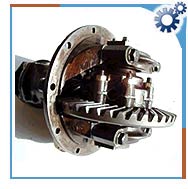 Differential gears link two shafts with a covering, forcing the
total of the rotational angles of the shafts to be the same as the
rotational angles of the covering. Arrangement of the system is done
in such a way that one axle turns faster than the other.
Differential gears link two shafts with a covering, forcing the
total of the rotational angles of the shafts to be the same as the
rotational angles of the covering. Arrangement of the system is done
in such a way that one axle turns faster than the other. When a differential gear is meshed with the other gear then the highly efficient torque is applied from the differential side gears to the axle shaft. When torque level decreases then the gear separating forces also decreases allowing the axle shaft to rotate independently. Differential gears can add or subtract the movement of two inputs. In practical terms, they will turn the number of revolutions proportional to the movements of both inputs. They are used to convert the lengthwise flow of power from the engine through the clutches, transmissions, and propeller shafts into a right-angle direction. This change allows the engine power to turn the wheels.
In the differential gears there are two coaxial gears, the pinions and the turntable. Pinions are mounted on intermediate shafts and these shafts are connected to a fixed carrier called the turntable. The differential gears are lubricated with a fluid that absorbs heat and increases the life and performance of the gears as well as the wheel. Regular driving subjects the fluid to high heat that breaks the fluid at a later stage. This results in the contact of two metals, which eventually increases the heat and prevents the gear from turning the car's wheel. So, the fluid should be properly checked in regular intervals.
Types of Differential Gears
There are two designs of differential gears, hypoid and spiral.
Spiral Differential - In spiral differential the pinion gears contacts the ring gears at its centerline .
Hypoid Gear - In the hypoid the pinion gear contacts the ring gear below the centerline. The size of pinion gear in hypoid differential is much smaller and the contact ratio is high, comparatively hypoid differential is much stronger than the spiral differential.
Applications
Differential gears in automobiles are the most common application of these gears. When the car is moving in a straight line, there is no movement of the differential gear with respect to its axis but when the car takes a turn then these gears help two wheels of the car to rotate differentially with respect to each other. When one wheel is stationary then the counterpart wheel rotates at twice of its expected speed.